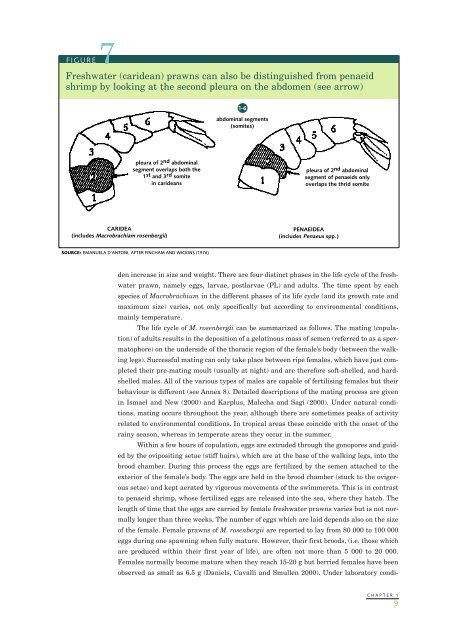You also want an ePaper? Increase the reach of your titles
YUMPU automatically turns print PDFs into web optimized ePapers that Google loves.
FIGURE7Freshwater (caridean) <strong>prawns</strong> can also be distinguished from penaeidshrimp by looking at the second pleura on the abdomen (see arrow)1-6abdominal segments(somites)pleura of 2 nd abdominalsegment overlaps both the1 st and 3 rd somitein carideanspleura of 2 nd abdominalsegment of penaeids onlyoverlaps the thrid somiteCARIDEA(includes Macrobrachiam rosenbergii)PENAEIDEA(includes Penaeus spp.)SOURCE: EMANUELA D’ANTONI, AFTER FINCHAM AND WICKINS (1976)den increase in size and weight. There are four distinct phases in the life cycle of the <strong>freshwater</strong>prawn, namely eggs, larvae, postlarvae (PL) and adults. The time spent by eachspecies of Macrobrachium in the different phases of its life cycle (and its growth rate andmaximum size) varies, not only specifically but according to environmental conditions,mainly temperature.The life cycle of M. rosenbergii can be summarized as follows. The mating (copulation)of adults results in the deposition of a gelatinous mass of semen (referred to as a spermatophore)on the underside of the thoracic region of the female’s body (between the walkinglegs). Successful mating can only take place between ripe females, which have just completedtheir pre-mating moult (usually at night) and are therefore soft-shelled, and hardshelledmales. All of the various types of males are capable of fertilising females but theirbehaviour is different (see Annex 8). Detailed descriptions of the mating process are givenin Ismael and New (2000) and Karplus, Malecha and Sagi (2000). Under natural conditions,mating occurs throughout the year, although there are sometimes peaks of activityrelated to environmental conditions. In tropical areas these coincide with the onset of therainy season, whereas in temperate areas they occur in the summer.Within a few hours of copulation, eggs are extruded through the gonopores and guidedby the ovipositing setae (stiff hairs), which are at the base of the walking legs, into thebrood chamber. During this process the eggs are fertilized by the semen attached to theexterior of the female’s body. The eggs are held in the brood chamber (stuck to the ovigeroussetae) and kept aerated by vigorous movements of the swimmerets. This is in contrastto penaeid shrimp, whose fertilized eggs are released into the sea, where they hatch. Thelength of time that the eggs are carried by female <strong>freshwater</strong> <strong>prawns</strong> varies but is not normallylonger than three weeks. The number of eggs which are laid depends also on the sizeof the female. Female <strong>prawns</strong> of M. rosenbergii are reported to lay from 80 000 to 100 000eggs during one spawning when fully mature. However, their first broods, (i.e. those whichare produced within their first year of life), are often not more than 5 000 to 20 000.Females normally become mature when they reach 15-20 g but berried females have beenobserved as small as 6.5 g (Daniels, Cavalli and Smullen 2000). Under laboratory condi-CHAPTER 19
















